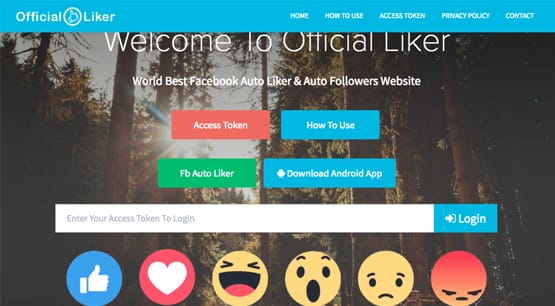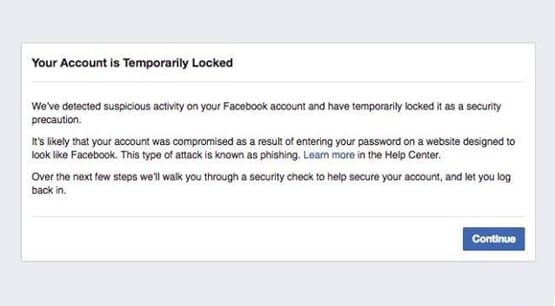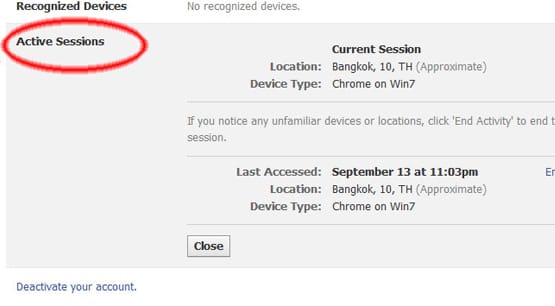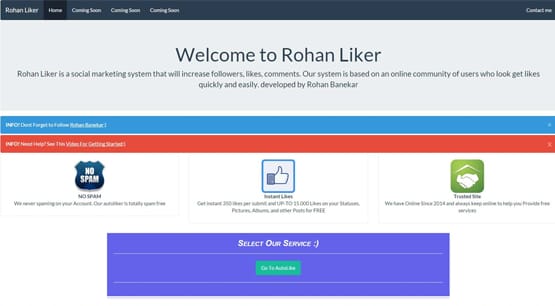Are You Risking a Ban By Using Social Media Auto Likers?

Auto liker apps tend to come in two varieties. Both of them are aimed at getting you more likes on your content and more followers for your account.
One type of auto liker puts you in a rotation along with every other user of the app. Whenever any user of the app posts new content, every other user of the app goes to like that content automatically. It’s sort of like being part of a broad, varied community, all mutually liking each others’ content.
The other kind of auto liker is simple an action your account takes. The app goes out and, based on criteria you select such as hashtags or keywords, will start liking random recent content. Some of them will also leave comments, either from a list bundled with the app or from a list you generate ahead of time.
This second kind of liker is far more commonplace. The idea is that as your account likes the content from other accounts, it should be relevant to yours – because of the keywords you have chosen – and the poster of that content investigates your account. When they find similar content, they choose to either like your content or follow your account as a whole. Boom: new follower, and you didn’t need to really do much of anything.
There are a few problems with this approach. The first problem is simply how ineffective it is as a method for growing an account.
How often do you check out the account of someone who likes your content? I doubt it’s very often. Most people don’t bother to check those accounts, other than maybe a cursory search to see whether or not they’re a bot.
Since only a small percentage of the people whose content you like will even bother to check on your account, you have an incredibly small chance of attracting them to follow you or like your content. That means you need an incredible volume of outgoing likes in order to get any incoming likes. It’s faster and easier to just join a like-for-like community or something.
The other major problem is that most social media auto liker apps will take over your account in other ways. They require you to generate an app authentication token and will use that token to control your account. You’ll often find that your account is sending DMs or posting content you don’t want it to post, but you gave it permission to do so.
Will Likes Get You Banned?
Let’s say you found a very straightforward auto liker app that doesn’t post on your behalf. All it does is what it says on the tin: goes out and likes content based on your specified hashtags and keywords.
Can this get you banned from your social network of choice?
Chances are, on its own, you’re probably safe. There’s only one potential rule that you might violate using such an app, and that’s the rate limit for likes. Since the app is using the social network’s API to do its liking, you’re not going to be able to exceed whatever the rate limit is for actions, since it’s a hard limitation on the code.
Maybe bumping up against the rate limit will raise some red flags, but most often the social network in question – be it Twitter, Instagram, Pinterest, or whatever else – is going to have bigger fish to fry.
All you’re really doing is spamming any like feed you may have and devaluing likes in general. What do I mean?
When you like 1,000 posts per day, everyone who follows you is going to see at least some of the content you like, if the social network has a feed for likes. Twitter, for example, will show some likes in the feeds of your followers, though it’s generally limited to the people who follow both you and the account you liked. Other social networks might do less filtering.
The power of a like from a brand comes from the weight of that brand and its followers. If a major brand likes my content, I can consider it a sort of minor endorsement and can use it to help gain new followers from sufficiently large accounts. If that brand is liking 1,000 posts a day, that like has no value and I can’t leverage it at all.
On any social network where you have a feed that shows all of the content you like, an auto liker will demolish your reputation. Everyone with half a brain will be able to see you’re using some kind of bot to like content, and it utterly devalues the like action from your brand.
Transparent Techniques
Using a basic, non-spammy liker probably won’t get you banned, but very few auto likers are actually that safe. Most of them will either leave comments or will post content on your behalf.
Any time your brand starts posting anything, be it a comment or fresh content, your followers will see it. Now imaging you have a bot leaving comments on content based on, say, geolocation tags. You end up leaving a “hey, thanks” comment on some people praising your brand. Sure, cool, that’s fine! Then you leave a “hey, thanks” comment on a post criticizing your brand. That sucks! Either you’re being snarky to a customer for no reason, or you’re transparently using a bot.
It gets even worse when the bot goes a little off the reservation. I’ve seen auto liker bots like content from accounts with zero followers. I’ve seen auto likers like selfies from children with vaguely-inappropriate comments. I’ve even seen auto likers praise the content posted by competitors!
None of this on its own is going to get you banned. However, it can earn you a reputation as a spammer. If you accumulate enough reports from people flagging you as a spammer, you’ll more likely end up banned because of it.
Now, if you’re using an auto liker that posts affiliate messages for itself on your feed, you’re a lot more likely to be labeled a spammer, and much more quickly as well. Posting content that is transparently bot-generated is a great way to get your account removed as a spam account. After all, no one wants to see posts for the latest social media auto liker in their feed, the same way no one wants to see posts about those discount Ray-Bans or whatever knock-off counterfeit Gucci is on the menu in China this month.
Bot Filtering
Many social networks are using increasingly sophisticated algorithms to monitor the content and actions taking place on their site. They will be able to identify patterns of actions that are typical of specific kinds of bot software.
Using an auto liker on your own might not be a big problem. However, when the social network can see the exact same string of actions happening on 10,000 different accounts, it’s really easy for them to take a look and determine if there’s a specific app causing it. If they decide that app isn’t something they should allow, well, what do you think is going to happen to your account?
At the very least, the app is going to be banned. This means you’ll find the app no longer works, and then you’re left to clean up the mess. If you paid for the app in the first place, you’re out the money, of course. There’s no chance these app developers are going to refund everyone when their spam platform gets banned.
In many cases, the social network might also sanction your account for using a spam app. Sometimes they revoke your access to the API, which can break any other app you’re using, including legitimate management apps. And, of course, in some cases they’ll just ban accounts that appear to have no value.
Account Theft
In some cases, auto liker apps don’t go through the usual API methods, because of how easily traceable they are. They might also want to take actions that the API doesn’t allow, like how until recently, no app could post on Instagram via the API.
If you’re using one of these apps, chances are it asked you to log into the platform through it. It’s not authenticating itself, it’s copying your login information to use so it can take unlimited “organic” actions on your behalf. There are still platform rate limits to account for, but it doesn’t have to obey API limitations when it has full access to your account.
This means a shady bot can do all kinds of things you might not want it to do. It can send out waves of DMs and then remove your message history so you don’t see that you sent them. It can follow and comment on any number of other accounts, and post content you might not want posted.
In worse instances, an app you log into in this manner can simply steal your information. After all, you’re already using a black hat app, what assurance do you have that this app isn’t going to hijack your account? If you give them your password, they can keep it for as long as they like. Maybe your account won’t be hijacked right away; the app developer might wait until they’ve stolen a sufficient amount of user data before mass-hijacking or even just selling the information.
Sure, you can use the app and then change your password, and that will keep your account safe, but you’re still risking a lot in the time before you change it.
Useless Metrics
At the end of the day, using any kind of social media auto liker is going to backfire on you. Sure, you might be sending out a ton of likes, and you might even be getting some likes in return, especially if you’re using a mutual like network as described way up in the introduction.
The problem is, those likes from cheap auto likers are pretty much useless.
As I mention in this post, it’s like writing 1,000 letters all addressed to yourself and mailing them out. After the post office filters them and sends them back your way, you get a bunch of letters in the mail. Cool, right? Well, except none of those letters come from real fans, they don’t lead to any potential customers, and they cost you money to print out and mail. You’re out the cost of postage, with nothing but a bunch of wasted paper to show for it.
When you’re using social media, the #1 thing you want out of it is customer relationships. You want people who are interested in you to follow you, and people who follow you to message you. You want to drag these people into your sales funnel via mailing lists and blog posts. You want to build up an audience, a positive reputation, and a public presence that makes you look reliable.
Auto likers undermine all of these goals. They make your account look shady and they bring in a lot of metrics that don’t help you grow or build an audience. In a lot of cases, you’re “reaching out” to accounts that are inactive, belong to people outside of your target audience, or are just so far outside your niche that they might as well be spam.
Plus, bots are easy to mess with. Have you ever seen a Twitter account that seems to reply to everyone who mentions their brand? You can do some goofy things by seeding tweets with that brand name when the rest of the tweet is irrelevant. Often, they don’t even have a keyword blacklist to avoid liking the competition or anything explicit. You don’t want random people to mess with your brand account and put words in your mouth, do you?









